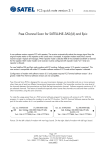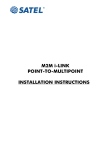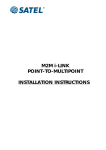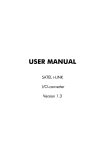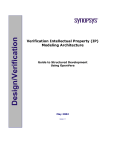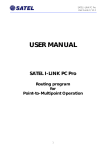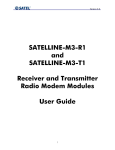Download USER GUIDE M2M Point – to – Multipoint
Transcript
USER GUIDE M2M Point – to – Multipoint M2M Point-to-Multipoint User Guide V2.0 TABLE OF CONTENTS 1 INSTALLATION ........................................................................................................................... 3 1.1 SUB-STATIONS..................................................................................................................... 3 1.2 MASTER STATION (PC) ......................................................................................................... 3 2 CONNECTING THE INPUTS AND OUTPUTS ............................................................................... 4 2.1 2.2 2.3 2.4 DIGITAL CONNECTIONS ..................................................................................................... 4 ANALOG INPUTS ................................................................................................................. 4 DIGITAL OUTPUTS ............................................................................................................... 4 ANALOG OUTPUTS.............................................................................................................. 4 3 PROGRAM ................................................................................................................................. 5 4 SETTINGS................................................................................................................................... 6 4.1 SATELLINE RADIO MODEM AND SATEL I-LINK 100 CONFIGURATIONS ................................ 6 5 USING THE PROGRAM ............................................................................................................... 7 5.1 5.2 5.3 5.4 5.5 5.6 5.7 5.8 5.9 6 SAVE / LOAD............................................................................................................................ 11 6.1 6.2 6.3 6.4 6.5 7 START .................................................................................................................................. 7 OPERATION WINDOW ........................................................................................................ 7 COM PORT.......................................................................................................................... 7 SLAVE ADDRESS ................................................................................................................... 7 GENERAL ............................................................................................................................. 8 SENDING DIGITAL DATA ..................................................................................................... 8 SENDING ANALOG DATA .................................................................................................... 8 RECEIVING ANALOG DATA ................................................................................................. 8 EDITING .............................................................................................................................. 9 SELECTED SLAVE SETTINGS ................................................................................................ 11 SAVING.............................................................................................................................. 11 LOADING OF THE NEW SLAVE........................................................................................... 11 CLOSING SLAVE ................................................................................................................ 11 CLOSING I-LINK PC PROGRAM.......................................................................................... 11 INDICATORS ............................................................................................................................ 12 7.1 ADJUSTABLE SETTINGS ...................................................................................................... 12 7.2 BOTTOM BAR .................................................................................................................... 12 8 FACTORY SETTINGS AND ACCESSORIES.................................................................................. 13 9 CONNECTION EXAMPLE.......................................................................................................... 14 10 CHANNEL CHANGE GENERAL................................................................................................ 15 10.1 HOW TO CHANGE THE CHANNEL IN MULTIPOINT OPERATION ...................................................... 15 1 M2M Point-to-Multipoint User Guide V2.0 GENERAL This installation manual provides you in brief with all the essential information you need to get your cordless SATEL M2M Multipoint package in working condition. The wireless SATELLINE radio modem enables the devices' mutual communication. SATELLINE-1870 radio modems operate on license-free radio frequencies and can therefore be taken into use immediately without separate permission from the authorities. All of the settings etc. needed for a connection have already been adjusted so all you have to do is the final hook-up. The Multipoint Package This package enables you to wirelessly control and monitor the operations of two sub stations with one master station. The equipment makes it possible to send and receive 4 status signals (switch or other digital status), or 2 analog signals/measurement data. The measuring sensors for analog data should be designed for 4....20 mA current loop data. All changes in the substation input (DIGITAL or ANALOG INPUT) are transmitted to the Master station display as visible output (DIGITAL or ANALOG OUTPUT). Correspondingly, separate controlling is possible directly from the master station to the sub-stations. Contents of the M2M Package: Number in the picture: 3 pcs of radio modems with antennas (1and 2) 2 pcs of I-LINK 100 I/O- converters (3) 3 pcs of interface cables (4) 3 pcs of power supplies (5) 1pc of I-LINK PC Multipoint programme 1pc installation instruction user guide for the I-LINK 100 2 M2M Point-to-Multipoint User Guide V2.0 1 INSTALLATION The installation part consists of the installation and how to make the wiring (paragraph 2 CONNECTING THE INPUTS AND OUTPUTS). The use of the program is explained in the paragraph 5 USING THE PROGRAM General Choose the places for installation where the products may be easily mounted. If at all possible, choose a place where there is nothing to obstruct (walls, etc.) the transmission of radio signals 'between' the antennas of the main drive and the sub-stations. 1.1 SUB-STATIONS 1. Connect antenna (1) to the radio modem (2). 2. Connect the interface cable (4) to the radio modem and the I-LINK 100 (3). 3. Connect the power supply (5) to the I-LINK 100 screw couplings +9 … +30 Vdc. Connect the power supply's black wire to the negative pole (-) and the red wire to the positive pole (+). Make the connections to the other equipment as well. The sub-stations are now installed.. 1.2 MASTER STATION (PC) 1. Connect the antenna (2) to the radio modem (1). 2. Connect the interface cable (4) to the radio modem and the PC's (3) COM port. 3. Connect the power supply (5) to the wall socket. The master station is now installed. 3 M2M Point-to-Multipoint User Guide V2.0 2 CONNECTING THE INPUTS AND OUTPUTS Once you have installed the M2M package, all you need to do is just connect the actual inputs and outputs. 2.1 DIGITAL CONNECTIONS Connect switch status or other data to any input of the sub-station (DIGITAL INPUT), so that you get a status change in the input, i.e. +12 V / 24 V 'ON or OFF'. You can take the + (plus) Voltage from the + - screw of the I-LINK 100, or from the separate + - output next to it. Digital Inputs Analog Inputs 2.2 ANALOG INPUTS Analog sensors and gauges should be connected to their own + and - inputs and outputs. Notice that the sensors need their own supply voltage, mentioned separately in connection with the delivery of the sensor. Choose the analog sensor transmission sequence with the I-LINK PC programme. 2.3 DIGITAL OUTPUTS Changes in the sub-station outputs are done by using commands on the master station display. When the main station input is pressed, the respective sub-station output relay contacts changes accordingly. The relay contacts are normally open. Each contact can be connected independently, and can perform the desired function by using them to connect plus or minus Voltage to the desired device. The contacts can also be used to control a 230 Volt device at maximum of 2 Amperes. 2.4 ANALOG OUTPUTS Connect the device you want to control to the output. Driving voltage Digital outputs Analog outputs To the controlled device When all outputs are connected, mount the power supply to the mains voltage. For more information concerning the functions of the I-LINK 100, see the I-LINK 100 user manual in the M2M package. 4 M2M Point-to-Multipoint User Guide V2.0 3 PROGRAM SATEL I-LINK PC is a Point-to-Multipoint program, that can be used to drive several SATEL ILINK 100 slaves connected to SATELLINE Radio Modems. The maximum number of slaves is 16 pcs. The program makes it possible to operate systems which are connected to the I/O -ports, to change values, monitor the radio link and Multipoint operation etc. Minimum requirements: PC 286, SATELLINE radio modem, SATEL I-LINK 100, I-LINK PC PROGRAM COM Port baud rate min. 9600 b/sec. Windows 95, 98, 2000, XP 5 M2M Point-to-Multipoint User Guide V2.0 4 SETTINGS NOTE! If you are using SATEL M2M- package, all setings in page are already done and you may continue from point 4 onwards. 4.1 SATELLINE RADIO MODEM AND SATEL I-LINK 100 CONFIGURATIONS BAUD RATE Set the baud rate of the SATELLINE radio modem. Check that the other parameters are “N, 8, 1” (8 data bits, no parity, 1 stop bit). Set the baud rate of the SATEL I-LINK100 by using the BAUD DIP -switches. 00=2.4, 10=4.8, 01=9.6, 11=19.2 (check that the SATELLINE radio modems have the same settings). PROTOCOL Set the SATEL I-LINK 100 PRTCL switch to the Multipoint position, P-to-MP. ADDRESS Set personal addresses to all SATEL I-LINK 100 slaves by using the ADDRESS DIP -switches. CONNECTIONS Before connecting the device to a power supply, first connect all inputs and outputs. More information about connections can be found at the end of the manual. 6 M2M Point-to-Multipoint User Guide V2.0 5 USING THE PROGRAM 5.1 START Instal the attached CD to your PC and open the SATEL I-LINK PC program by double clicking the -icon. 5.2 OPERATION WINDOW Open a new operation window from the toolbar list by clicking the -button on the upper left corner, or Open by clicking on the File Menu, opening "New Slave". Open your own window to all slaves. Note that the maximum number of slaves in this program is 16. Arrange the display by using the Windows Menu or the -buttons. 5.3 COM PORT Open the COM- port from the toolbar list by clicking “Master Config” and select “Open ComPort”. Set the same parameters as you have set for the SATELLINE radio modem and SATEL I-LINK 100, then press OK. If there are no COM -port settings, the program will automatically ask for them. 5.4 SLAVE ADDRESS When the new slave is opened, the program will automatically set the address for it. To make manual adjustments, click anywhere on the empty table using the right mouse button, and select “Set slave address”. Insert the new address, and then press OK. NOTE! THE BASIC SETTINGS HAVE NOW BEEN ESTABLISHED AND THE SATEL I-LINK PC IS READY TO SEND AND RECEIVE INFORMATION. 7 M2M Point-to-Multipoint User Guide V2.0 5.5 GENERAL Changes in the sub-station outputs are done by using commands on the master station display. Changes in the sub-station inputs are shown respectively on the master station display. When the sub-station Inputs I1…I4 level changes from 0 to +12 … +24 Vdc or vice versa, the indicator in the master station display changes respectively. When the main station’ digital output is pressed, the respective sub-station output relay contacts changes accordingly. The relay contacts are normally open. Each contact can be connected independently, and can perform the desired function by using them to connect plus or minus Voltage to the desired device. The contacts can also be used to control a +12 … +24 Vdc or 230 Vac devices at maximum of 2 Amperes. Changing of the analog level in the sub station analog output is done by moving the “analog” cursor in the display. Analog information coming from the sub station is shown in the display as 0…100 % value bar. 5.6 SENDING DIGITAL DATA To change the slave's digital value, click the grey “Digital Output” circle dot. During the transmission the dot is yellow. When the transmission is done, the circle will change to green. If the transmission fails, the “Operation” signal will turn red. 5.7 SENDING ANALOG DATA Move the “Analog Output Cursor” or change the number at the side. Press “Send Analog Data” and the levels will be sent to the Slave's “Analog Output”. If the transmission fails, the “Operation” signal will turn red. Note that “Analog Output” can only be sent by pressing “Send Analog Data”. 5.8 RECEIVING ANALOG DATA There are three different modes to receive data; manual, automatic or time. The settings can be done separately for each window. 8 M2M Point-to-Multipoint User Guide V2.0 Manual update For manual update – click anywhere on the empty table using the right mouse button - select “Set update mode” , and press “Manual”. Using this setting, the slave information for the chosen window is updated only when “Manual Update” circle-dot in this window is pressed. Automatic For automatic update – click anywhere on the empty table using the right mouse button - select “Set update mode”, and press “Auto”. Using this setting, the slave information for the chosen window is updated with maximum speed. If only one slave has an auto setting, the update speed is about 1 second. Every new auto setting increases the update time. NOTE! Use this setting for the Slaves only, if it is absolutely necessary. The Auto setting makes maximal use of the radio frequency. The continuous reservation of radio frequency is not generally recommended. Time For a Time based update – click anywhere on the empty table using the right mouse button select “Set update mode”, and press “Time”, select the time and press SET. The time interval can be from 5 seconds up to …24 hours. Using this setting, the update information from the slave to the chosen window will be in accordance with the “Select time” setting. 5.9 EDITING Slave window layout Click anywhere on the empty table using the right mouse button, select "Set layout style" and set it for “Normal”, “Input only” or “Output only”. The inputs and outputs can be seen in the window simultaneously or separately, depending on the settings. 9 M2M Point-to-Multipoint User Guide V2.0 Changing the Slave name Click anywhere on the empty table using the right mouse button – select "Set Name" – type the new name and press OK. Changing Input / Output names Click on the right mouse button on top of the text that you want to edit, make the changes and press ok. Unit Conversion Normally the analog input and output unit is shown as % and the scaling is from 0 to 100. The unit can be changed to be any other unit maximum five characters. The value can also be re-scaled by setting the minimum and maximum values that the sensor and device applies. Click anywhere on the empty table of the selected slave using the right mouse button, select "Set Unit Conversion” and click. Set new values and re-scale the min and max value. Execute the function by clicking Use. 10 M2M Point-to-Multipoint User Guide V2.0 6 SAVE / LOAD 6.1 SELECTED SLAVE SETTINGS Click anywhere on the empty table of the selected slave using the right mouse button, select "Save Settings" and press OK. 6.2 SAVING Select FILE - "Save All", select path and save. This function will save all slaves using their current names. 6.3 LOADING OF THE NEW SLAVE Select FILE - "Load Slave(s)" and open the file. Because the information of the now loaded slave may be different from what it currently is, the program asks “Do you want to update slave(s)? Select Yes / No". 6.4 CLOSING SLAVE Click anywhere on the empty table of the selected slave using the right mouse button and click "Close". In the event that the program has not be Saved, the program asks “Are you sure you want to close slave? Select Yes / No." 6.5 CLOSING I-LINK PC PROGRAM Select FILE – EXIT. If any of the Slaves are still open, the program asks “Are you sure?” Select Yes /No. 11 M2M Point-to-Multipoint User Guide V2.0 7 INDICATORS 7.1 ADJUSTABLE SETTINGS OBJECT Operation Digital Output Digital Input Analog Output Analog Input ACTION Status of the operation State of the outputs State of the inputs The output level in % The input level in % OUTCOME Green= OK 0 = 4 mA Yellow = Running Yellow = Running Yellow = Running 100 = 20 mA Yellow = 0 ... 25 % Green = 25 ... 100 % Red = 100 ... 125 % 0 ... 4 mA 4 ... 20 mA 20 ... 25 mA Green= OK Green= OK 7.2 BOTTOM BAR TEXT Manual tai Auto ”00:00:00” Address: FUNCTION Shows the analog input update selection Shows the analog input update time Shows the address of the slave 12 Red = Fail Grey = OFF Grey = OFF M2M Point-to-Multipoint User Guide V2.0 8 FACTORY SETTINGS and ACCESSORIES The I-LINK100 I/O-converter is shipped with the following default: FIXED SETTINGS DEFINED AT THE TIME OF ORDER PRTCL, protocol -switch 1 = P-to-MP ADDRESS 1000000 and 0100000 BAUD 01 = 9600 bps DE 3, Alarm delay 0 = no delay SM 4, Safe Mode 0 = Safe Mode OFF HS 5, Handshaking 0 = CTS ON TIME, Analogue transmission interval 000 =120 minutes Interface cables DEVICE PC I-LINK 100 RADIO MODEM SATELLINE-1870 SATELLINE-1870 CABLE CRS-18F CRS-18IF 13 M2M Point-to-Multipoint User Guide V2.0 9 CONNECTION EXAMPLE 14 M2M Point-to-Multipoint User Guide V2.0 10 CHANNEL CHANGE GENERAL The radio modems of the M2M-package operate on the European license free frequency band. This band has several different channels. Sometimes it may happen that few systems use the same channel. If this occurs, the system stability may change and behave in an uncertain manner. However, if this happens, it is possible to change the radio modems to another channel. The standard M2M sale s package is pre-set to a specific channel and changes are not needed in order to start the normal operation. The changes are needed only, if the system doesn’t work properl y. 10.1 How to change the channel in Multipoint operation In multipoint operation the channels can be changed using the I-LINK PC Program; by tabbing the Window and selecting the Channel Selector. Channel selector 15 M2M Point-to-Multipoint User Guide V2.0 The program has not yet checked the operational channel and following text displays “Your current channel is not known and therefore all the scan controls are unavailable. Do you want to check it now? (Recommended)”. By pressing “Yes” the program will find the operational channel. As a result of the scan the operational channel is shown at the bottom bar. 16 M2M Point-to-Multipoint User Guide V2.0 In order to check all possible channels (10 pcs), the program suggests scanning all channels. This is possible by pressing, “Yes”. All channels are checked and the program suggests to automatically selecting the best channel by pressing “Yes”. If the current channel is free from interferences the colour of the channel button is green and the channel will not be changed. If there is interference i.e. the current channel is occupied by other users the colour of the channel button is yellow (medium interference) or red (strong interference). By pressing “Yes”, the program will automatically set the system to operate on a new channel. The channels can be changed manually by selecting the one that has the highest number and pressing “Change to Selected Channel”. By answering, “Yes” all units are changed to the new channel. 17 M2M Point-to-Multipoint User Guide V2.0 18 SATEL OY Meriniitynkatu 17, P.O. Box 142 24101 Salo, FINLAND Tel: +358 2 777 7800 Fax: +358 2 777 7810 E-mail [email protected] www.satel.fi





















